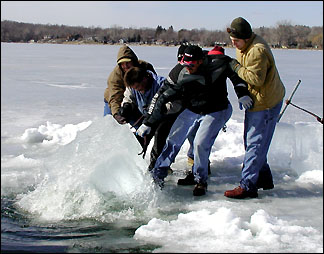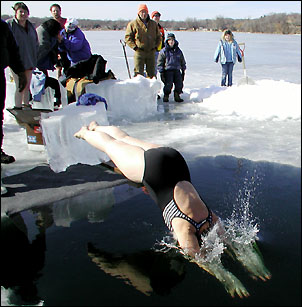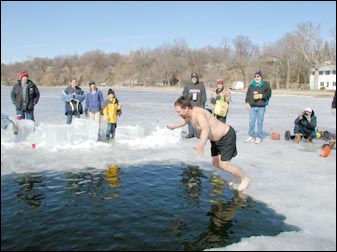'Jump in the Lake' marks 20th anniversary
On Sunday afternoon, at the 20th annual "Jump in the Lake," Koshiol and ten other people took the plunge. Three were first-timers; the rest were repeat swimmers.
 "This is a symbolic celebration of life," said Koshiol, who has organized the event since 1985. Sometimes people need to do something just for fun, especially in times like these while the country is at war, and things might not seem great, said Koshiol.
"This is a symbolic celebration of life," said Koshiol, who has organized the event since 1985. Sometimes people need to do something just for fun, especially in times like these while the country is at war, and things might not seem great, said Koshiol.
Before the actual jump, it takes about an hour to creat a hole in the ice. These volunteers wrestled a large ice chunck out of Lake Koronis. Making a hole, and working up a sweat, is needed before jumping in the frigid water. This year, the "Jump in the Lake" marked its 20th year.
Jumping in freezing water is exhilarating, and reminds you how it feels to be alive, he added.
Before he jumped, Koshiol stood on a chunk of ice, dedicated the event to friends and jumpers who have passed away, and toasted the other jumpers and the crowd for having fun. "This is a way of telling the rest of the world there's no reason to be bound by your lives," Koshiol told the group before diving into the icy water.
One by one, five men and six women jumped, dove, or slid into the frigid water through a six-feet by ten-feet hole cut through the still two-feet-thick ice near Veteran's Memorial Park.
Seven of the jumpers were locals: Carol and Herb Ambrose, John Dahl, Koshiol, Pete Larson, Shannon Lee, and Tiff Wolff. The other three jumpers this year came from New London, Richmond, and St. Anna.
This was the first year that the women who jumped outnumbered the men, said Koshiol.
While most of the jumpers said they do it for the rush, some had other reasons for jumping into the icy water. Lee, who now has jumped five times, looks at the tradition as a way to thumb her nose at winter. It also does wonders to get rid of wrinkles, she said, laughing, because pores in the skin tighten in response to the cold water.
"Doing this keeps me young at heart," said Dahl, pointing out that as he approaches 40, feeling young is important. Dahl, who made his first jump in 1989 and has jumped every year since, had the most jumps this year, besides Koshiol.
 First-time jumper Sue Mauderer of St. Anna was a watcher-turned-jumper. This year -╩after watching others jump for the last five years - Mauderer decided that she needed a little adventure in her own life. "Why not enjoy the lake year-around?" she wondered.
First-time jumper Sue Mauderer of St. Anna was a watcher-turned-jumper. This year -╩after watching others jump for the last five years - Mauderer decided that she needed a little adventure in her own life. "Why not enjoy the lake year-around?" she wondered.
Sue Mauderer, a first-time participant from St. Anna, dives into the icy water of Lake Koronis on Sunday. For the first time, women jumpers outnumbered men jumpers this year.
Koshiol began the tradition of jumping in icy water in 1985 when his volleyball team was looking for something exciting to do. When he was an elementary school in Paynesville, Koshiol read a "Weekly Reader" article about Russians who would use dynamite to blow a hole in the ice and then go swimming.
When he suggested cutting a hole in the ice in Lake Koronis and jumping in, he had no idea that he would start a tradition that would last this long.
Before the first event, Koshiol and some buddies attempted to cut a hole in the ice with chain saws. But the ice at least a foot deeper than the chain saws, so the resulting hole was more like an ice puddle, he said.
Through the years, the group's ice-cutting technique has improved and is, in fact, an important part of the experience, since working up a sweat creating the hole makes the jump refreshing, to say the least.
To create the hole, they use ice augers and antique ice saws. After laboring for more than an hour to make the hole, Larsen found himself soaked from the thighs down from splashing water. In Larsen's case, his legs and feet were already so cold from being wet during a frigid March wind, the water felt warm by comparison, he said.
 Cutting ice hasn't been necessary every year, though. One year, the jumpers arrived at the lake to find just a skin of ice on the surface. Instead of using augers and saws, Koshiol and his friends used a canoe as an ice breaker to create a plunge area in which swimmers waded into the water.
Cutting ice hasn't been necessary every year, though. One year, the jumpers arrived at the lake to find just a skin of ice on the surface. Instead of using augers and saws, Koshiol and his friends used a canoe as an ice breaker to create a plunge area in which swimmers waded into the water.
John Dahl, who has participated in the 'Jump in the Lake' since 1989, jumps from the ice on Lake Koronis into the frigid water.
Through the years, the "Jump in the Lake" has been held in sunny, 40-degree weather and in sub-zero temperatures with snow, sleet, and rain storms, said Koshiol.
Participants once jumped from a lifeguard tower through a huge hole. Another year the group drug the beach's slide onto the ice, and participants slid into the water.
Koshiol even tried to get a band to perform for the event one year, but he was told that it would be too difficult for the guitarists to play with frozen fingers.
The largest number of jumpers was 28; the smallest was two, Koshiol and Dahl. Usually, about 10 jumpers participate in the event.
Part of the fun is the celebration after the jump, so usually the crowd outnumbers the actual jumpers. Up- to 60 people have come just to watch, said Koshiol. This year, an audience of 20 witnessed the anniversary jump into Lake Koronis.
Contact the author at editor@paynesvillepress.com • Return to News Menu
Home | Marketplace | Community